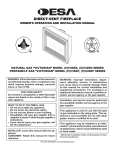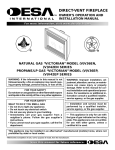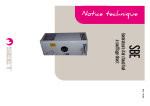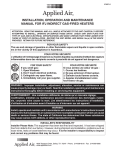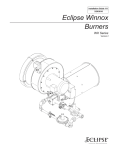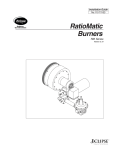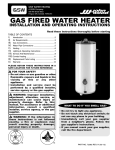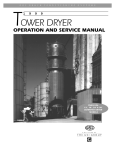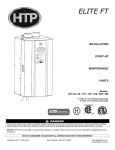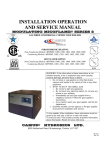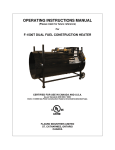Download GSW G65 User's Manual
Transcript
COMMERCIAL GAS WATER HEATER INSTALLATION, OPERATING AND MAINTENANCE INSTRUCTION MANUAL WARNING: If the information in these instructions is not followed exactly, a fire or explosion may result causing property damage, personal injury or death. - Do not store or use gasoline or other flammable vapors and liquids in the vicinity of this or any other appliance. - WHAT TO DO IF YOU SMELL GAS - Do not try to light any appliance. - Do not touch any electrical switch; do not use any phone in your building. - Immediately call your gas supplier from a neighbor’s phone. Follow the gas supplier’s instructions. - If you cannot reach your gas supplier, call the fire department. - Installation and service must be performed by a qualified installer, service agency or the gas supplier. READ THESE INSTRUCTIONS THOROUGHLY BEFORE STARTING AND RETAIN THESE INSTRUCTIONS IN A SAFE LOCATION FOR FUTURE REFERENCE 71781 IMPORTANT LOCATION FOR THE INSTALLER AND USER OF THIS GAS FIRED WATER HEATER Location selected should be as close to the stack or chimney as practical and as centralized with the piping system as possible. Heater should be located in an area not subject to freezing temperatures. These instructions have been written for the proper installation and safe operation of this water heater. The installation must conform with one or more of the following as applicable: Canadian Installation: 1. The latest edition of CAN/CGA B149. 2. Public Utility and/or local Codes U.S. Installation: The water heater should be located so that the controls and drain are easily accessible. The heater should be located in an area where leakage of the tank or connections will not result in damage to the area adjacent to the water heater or to lower floors of the structure. When such locations cannot be provided, it is recommended that a suitable drain pan be installed under the heater. Such pans should be a maximum 2” deep and have a minimum length and width at least two inches greater than the diameter of the water heater and should be piped to an adequate drain. The pan must not restrict combustion air flow. Under no circumstances is the manufacturer to be held liable for any water damage in connection with this water heater. 1. Public Utility and/or local Codes 2. The latest edition of the National Fuel Gas Code ANSI Z 223.1/NFPA 54 The water heater must be level on the floor surface. WARNING This water heater must be installed strictly in accordance with the detailed instructions enclosed and local building codes. It must be installed with a proper temperature and pressure relief valve which may release water in normal operation. It is also possible that connections to the water heater, or the water heater itself may develop leaks. IT IS THEREFORE IMPERATIVE that the water heater be installed so that any water is directed to an adequate drain in such a way that it cannot damage the building, furniture, carpeting or other property subject to water damage. THE COMPANY CANNOT BE HELD RESPONSIBLE for damage caused by water from the water heater, pressure relief valve or related fittings where adequate provision to drain such water has not been made. Closets without drains and carpeted areas are examples of unsuitable locations for any water heater. Any enclosure surrounding the installation must allow an adequate supply of ventilation and combustion air to the water heater. Otherwise sufficient air must be drawn from outside the enclosure. Air may be drawn into the enclosure through an opening. The opening shall have a free area of 1 square inch per thousand BTU’s and be located below 18 inches and above 6 inches as measured to the floor. Chemical vapour corrosion can occur anywhere that flue gases are carrying cleaning solvents, refrigerants, pool chemicals, chlorine salts. The location of the water heater should not be near any of these chemicals. Minimum clearances from the water heater and venting arrangement to combustible materials are: ( See also Fig. 1 and 2). Electronic Ignition Model -G65 3 inches from sides 3 inches from back 6 inches above vent pipe The warranty on this water heater is in effect only when the heater is installed and operated in accordance with these instructions. The manufacturer of this heater will not be liable for any damage resulting from failure to comply with these instructions. IMPORTANT: Before starting the installation read the rating plate on the heater. The gas listed must be the same as the gas supplied to the premises. A heater designed for Natural Gas must only be hooked up to a natural gas supply, and likewise, a heater designed for Propane Gas must only be hooked up to propane. DO NOT PROCEED UNLESS GAS TYPE OF HEATER AND GAS SUPPLY HAVE BEEN IDENTIFIED TO BE THE SAME. Electronic Ignition Models - (all others) 6 inches from sides 6 inches from back 6 inches above vent pipe Standing Pilot Models 6 inches from sides 6 inches from back 6 inches above vent pipe CAUTION: When this heater is installed directly on carpeting, carpeting must be protected by a metal or wood panel beneath the appliance, extending beyond the full width and depth of the appliance by at least 3 inches in any direction. If the appliance is installed in an alcove, the entire floor must be covered by the panel. Failure to heed this warning may result in fire hazard. Page 1 Figure 1 1. Cold water inlet 2. Hot water outlet 3. Gas supply manual shut-off valve 4. Sediment trap 5. Union - ground joint type 6. Gas control 7. Temperature & pressure relief valve 8. Floor drain 9. Drain pan (if used) Figure 3 seal tightly Location of pressure relief and/or expansion tank if a check valve or pressure reducing valve is in the cold water supply to the house. 2 Use option 1 or 2 as convenient. If pressure relief valve is used, select one with a setting 25 psi. below rating at tank. 1 10. Water supply to meter 11. Water supply to home 12. Water meter with backflow preventer 13. Overflow 14. Pressure relief valve 15. Expansion tank 3 7 5 15 11 6” 4 14 9 6 Option 2 12 13 8 10 Figure 2 3” 6 3” 3” 12 DRAFT HOOD Option 1 1/4 SHEET METAL SCREWS MAINTAIN 26” FOR ACCESS Page 2 WATER PIPING Pipes and fittings should be installed in compliance with the installation drawing. Makes sure the dip tube is in the cold water fitting and water connections are made correctly. Have the installer show you where the water shut-off valve for the water heater has been installed so that you know where and how to shut the water off. It is recommended that such a valve be located in close proximity to the cold water inlet of the water heater. (See installation drawing, Figure 3). Connect the cold water supply to the fitting marked “COLD” the hot water outlet to the fitting marked “HOT”. Do not apply heat to either of these fittings. It is imperative that no heat be applied to these fittings as they contain a non-metallic tube. When marking these connections, always use a good grade of pipe joint compound and be certain that all fittings are drawn up tight. After piping has been installed, allow tank to fill up with water and check connections for leaks. To ensure complete filling of the tank, allow air to exit by opening the nearest hot water faucet until a constant flow of water is obtained. be equal to or greater than the input to the water heater. Water heaters intended to be shipped to Canadian destinations may have the temperature and pressure relief valve factory installed. Any replacement valve must meet the latest edition of CAN 1-4.4, the Standard for “Temperature, Pressure, Temperature and Pressure Relief Valves and Vacuum Relief Valves.” Relief valve piping must terminate 6 inches above a floor drain or external to the building. Do not thread, cap or plug the end of this discharge line. Be certain that no contact is made with any live electrical part. Do not connect discharge line directly to drain. See figure 3. To prevent bodily injury, hazard to life or damage to property, the relief valve must be allowed to discharge water in the event of excessive temperature or pressure developing in the water heater. The function of the temperature and pressure relief valve is to discharge water in quantities should circumstances demand. If the discharge pipe is not directed to a drain as shown in Figure 3 or other suitable means, the water flow may cause property damage. The discharge line: 1. Shall not be reduced by a coupling or any other restriction; 2. Must not be plugged, or blocked; Check your area for water hardness. Hard water conditions can shorten tank life or cause excessive maintenance. When hard water conditions exist water softening is the best answer to protect both the water heater and the appliances using hot water. 3. Must be of material capable of withstanding 210oF, without distortion; 4. Must be installed so as to allow complete drainage of both the temperature and pressure relief valve and discharge lines; Pressure Build-up in a Water System 5. Must terminate at an adequate drain; and During the heating cycle of the water heater, the water expands, creating a pressure build-up in the water system. The water supply meter may contain a check valve or back-flow preventer, creating a closed water system. A method of controlling thermal expansion would then be required. Contact the water supplier or local plumbing inspector for instructions to control the situation. 6. Must not have any valve installed between the relief valve and the water heater. A temperature and pressure relief valve must be installed on the water heater (150 p.s.i maximum pressure setting. See Temperature and Pressure Relief Valve, below.) Should the relief valve discharge water, a potentially dangerous situation may be indicated and must be investigated. Have the operation of the heater checked by a qualified service person. Temperature and Pressure Relief Valve For protection against excessive pressure and/or temperatures, a temperature and pressure relief valve must be installed in the opening marked “T&P VALVE” - a design certified by a nationally recognized testing laboratory that maintains periodic inspection of production of listed equipment or materials, as meeting the requirements of Relief Valves and Automatic Gas Shutoff Devices for Hot Water Supply Systems, ANSI Z 21.22 - latest edition. Pressure rating of the valve must not exceed the working pressure shown on the rating plate of the water heater. The discharge capacity must Page 3 Failure to install and maintain a new, properly listed temperature and pressure relief valve will release the manufacturer from any claims which may result from excessive temperature or water pressure. WARNING: Do not attempt to operate this water heater with the cold water inlet valve close. Manually operate temperature and pressure relief valve at least once a year. Standing clear of the outlet, (discharge water will be hot), lift and release the lever handle on the temperature and pressure relief valve to make sure the valve operates freely. NEVER OPERATE THE HEATER IF IT IS NOT COMPLETELY FILLED WITH WATER. TO MAKE SURE THE HEATER IS FILLED, OPEN THE HOT FAUCET OF TAP UNTIL A FULL FLOW OF WATER IS VISIBLE WITH NO AIR ESCAPING. GAS CONNECTIONS IMPORTANT: GAS SUPPLY HAVE YOU CHECKED THE GAS SUPPLIED AND COMPARED IT WITH THE GAS MARKED ON THE RATING PLATE? SEE ALSO WARNING ON PAGE 1. The installation of this appliance must conform to applicable local codes and local authorities having jurisdictions. NEVER USE A MATCH OR OPEN FLAME TO TEST FOR GAS LEAKS. A FIRE OR EXPLOSION COULD RESULT. Install the gas piping as indicated in Figure 2. Use only new pipe and fittings with sound, clean-cut pipe thread. Sealing compound must conform to the applicable code for pipe sealing compound approved for use with natural gas and propane. It is important to have a readily accessible manual shut-off valve in the gas line supplying the heater, close to the heater. A drip leg must be installed ahead of the gas control valve to help trap sediments and foreign material. The maximum inlet gas pressure to the appliance must not exceed the gas pressure marked on the rating plate: 10.5” W.C. for natural gas and 13” W.C. for propane gas. The minimum supply pressure for the purpose of input adjustment is 1” above manifold pressure. The appliance and its individual shut-off valve must be disconnected from the gas supply piping system during any pressure testing of that system at test pressures in excess of 1/2 psig (3.5 kPa) A ground-joint union must be installed ahead of the gas valve to permit easy removal of the unit. The appliance must be isolated from the gas supply piping system by closing its individual manual shut-off valve during any pressure testing of the gas supply piping system at least pressures equal to or, less then 1/2 psig(3.5kPA) Pipe sizing and the number of fittings used must conform to the National Fuel Gas Code, Natural Gas Installation Code B.149.1 or Propane Gas Installation Code B149.2. The appliance and its gas connection must be leak tested before placing the appliance in operation. The input rating of the appliance should be checked against the actual input and the manifold pressure adjusted to give the correct input. In no case should the input exceed the rated input. Overfiring and damage to the appliance will result. High altitude installations require an input check since overfiring is more likely. All leak testing must be done with soapy water solution. Table I Gas Supply Line Sizes (Inches) (Based on pressure drop of 0.3 inches water column) Correct Gas Pipe Size for Heaters Operating on: NATURAL GAS PROPANE Specific gravity 0.6 Specific gravity 1.53 RATE BTU INPUT 30 60 90 120 150 180 210 30 60 90 120 150 180 210 58,000 95,000 150,000 200,000 250,000 300,000 400,000 500,000 600,000 750,000 1/2 3/4 3/4 1 1 1-1/4 1-1/4 1-1/4 1-1/2 1-1/2 3/4 1 1 1-1/4 1-1/4 1-1/4 1-1/2 1-1/2 2 2 3/4 1 1 1-1/4 1-1/4 1-1/4 1-1/2 2 2 2 3/4 1 1-1/4 1-1/4 1-1/4 1-1/2 1-1/2 2 2 2 1 1-1/4 1-1/4 1-1/4 1-1/4 1-1/2 2 2 2 3 1 1-1/4 1-1/4 1-1/4 1-1/2 1-1/2 2 2 2 3 1 1-1/4 1-1/4 1-1/4 1-1/2 1-1/2 2 2 2 3 1/2 3/4 3/4 3/4 1 1 1-1/4 1-1/4 1-1/4 1-1/4 1/2 3/4 3/4 1 1 1-1/4 1-1/4 1-1/4 1-1/2 1-1/2 1/2 3/4 1 1 1 1-1/4 1-1/4 1-1/4 1-1/2 2 1/2 1 1 1-1/4 1-1/4 1-1/4 1-1/4 1-1/2 1-1/2 2 1/2 1 1 1-1/4 1-1/4 1-1/4 1-1/2 1-1/2 2 2 1/2 1 1 1-1/4 1-1/4 1-1/4 1-1/2 1-1/2 2 2 1/2 1 1-1/4 1-1/4 1-1/4 1-1/4 1-1/2 1-1/2 2 2 DISTANCE TO METER IN FEET Page 4 DISTANCE TO METER IN FEET Table II No. of seconds required to consume 1 cu. ft. of gas. INPUT BTU/HR. NATURAL GAS 1000 BTU/CU. FT. 58,000 90,000 135,000 160,000 180,000 200,000 225,000 270,000 315,000 360,000 62 40 27 22 20 18 16 13 12 10 PROPANE 2500 BTU/CU. FT. SEC. SEC. SEC. SEC. SEC. SEC. SEC. SEC. SEC. SEC. 155 SEC. 100 SEC. 67 SEC. 56 SEC. 50 SEC. 45 SEC. 40 SEC. 33 SEC. 29 SEC. 25 SEC. VENTING VENT TOP OR CAP To carry off the products of combustion, a vent pipe must be attached to the drafthood of the heater and connected to a chimney vent of adequate height and area. Venting connections should be made in accordance with all codes and ordinances which apply. Ensure that the vent pipe is securely fastened to the draft hood and that the draft hood is properly attached to the heater. For a single heater installation the vent pipe must be sized no smaller than the flue size of the heater. Horizontal runs of vent pipe should be installed with a rise of at least 1/4” per foot of length. The vertical connector rise of vent pipe above the draft hood, before any fittings, should be as great as possible. When more then one heater is installed and the vents are combined, the area of the horizontal manifold and common vent should be at least equal to the area of the largest single vent, plus 50% of the area of all other vents joining it (see Vent Size Chart below) (For example, to combine two 6” vents with a 5” vent, the area of the combined vent would be equal to 28 + 28/2+20/2 equals 52 square inches - use a minimum 9 inch common vent and manifold). Units with larger inputs must be vented below others. When using a common vent connector, it shall be at the highest practical level. DIA. IN. AREA SQ. IN. DIA. IN. AREA SQ. IN. 5 6 7 8 9 20 28 38 50 64 10 12 14 16 79 113 154 201 COMMON CHIMNEY VENT MANIFOLD VENT CONNECTOR CONNECTOR RISE TEE CAPPED The chimney vent must be extended at least two feet higher than any obstruction located within 10 feet. Where a back draft exists, the cause must be determined and corrected. A flue cap on the chimney vent may correct the situation. However, if the back draft cannot be corrected, if long horizontal vent pipe runs are necessary, or if a suitable flue cannot be obtained, a mechanical exhaust may be required to ensure proper venting and combustion. Some local codes prohibit connecting a gas heater to a flue or chimney with coal or oil fired equipment. Therefore, these connections should be avoided. However, where a separate chimney is not available, the flue pipe from the water heater should enter the common flue or chimney at a point ABOVE the flue pipe from the coal or oil fired equipment. Improper venting may result in poor combustion, sooting and serious damage to the heater. Page 5 FLUE DAMPER Flue Damper Venting Flue Damper Installation For Models equipped with a flue damper, the following instructions must be followed. It is recommended to leave a minimum 24” clearance from the actuator side of the flue damper for service access. Step 1: The vent pipe (flue pipe) must be installed without restriction or reduction in size. Slope the horizontal run upwards to the chimney at least 1/4” per foot. Fasten all joints with sheet metal screws. (See Figure 4) Venting must be inspected every three months for blockage and problems due to age of the vent piping. Damper Position Indicator Place flue damper on top pan into flue collector. The rail support must be screwed to the top pan. The three pre-drilled holes on the casing top must align with the three holes on the rail support. The rail support must fit flush with the casing top. The damper position indicator can be found on the flue collar of the flue damper. (See Figure 4). Heater Wiring Step 2: Install the draft hood which is supplied with the heater in the carton to the heater top. Fasten the draft hood with the four sheet metal screws supplied. Step 3: Remove junction box cover plugs. Remove flue damper cover. The wiring harness provided plugs into the four plug female molex connector (use strain relief connector provided). Molex plugs mate together one way only. Follow local codes for all electrical work. To reduce risk of shock or possible electrocution, the heater must be electrically grounded in accordance with local codes or, in the absence of local codes, with the National Electrical Code, ANSI / NFPA 70. If any of the original wiring must be replaced use only type 105oC thermoplastic or equivalent. To manually set the damper in the open position, see diagram below. NOTE: THE FLUE DAMPER MUST BE IN THE OPEN POSITION WHEN APPLIANCE, PILOT AND OR MAIN BURNERS ARE ON. THIS SHOULD BE CHECKED BY THE INSTALLER BEFORE LEAVING. Figure 4 MOUNTING SCREWS (4) VENT DAMPER DAMPER SHAFT POSITION T O H C LD O CLOSED OPEN JUNCTION BOX “OPEN” POSITION JUNCTION BOX COVER CLOSED OPEN “CLOSED” POSITION Page 6 DAMPER POSITION INDICATOR Connection Diagram Appliance in Standby Condition 128 VAC 24 V SL VENT DAMPER R1 (N.C.) M 2 R2 (N.O.) SS1 E.C.O. (N.O.) TH.ST 1 SS2 (N.O.) 3 E.S. (N.O.) 4 GNO VALVE The motor is energized during appliance thermostat “off” cycle. The flue damper is the “closed” position. Circuit diagram is as shown. Schematic - Valve and Ignition Module 128V H NEUTRAL 24V R1 (N.C.) M R2 (N.O.) 2 E.C.O SS2 (N.O.) 3 TH.ST 4 (N.O.) E.S. (N.O.) SL VENT DAMPER PLANE SENSOR TRIAC HSI FLAME SENSING BURNER ONO HV PILOT BURNER N.S.I. RELAY DRIVE ONO N.S.I. DUAL VALVE OUT X PILOT VALVE AND IGNITION MODULE Page 7 X PV 24 DC POWER SUPPLY On Appliance Call for Heat - Stage 1 20 VAC The thermostat contacts close and they relay coil is energized. Relay contacts R1 (N.C.) now open, and the motor is de-energized. 24 VAC E.C.O. R1 (N.C.) 2 Relay contacts R2 (N.O.) now close. FUSE M R2 (N.O.) SS2 (N.O.) 3 1 E.S.(N.O.) TH. 4 VENT DAMPER VALVE GND. On Appliance Call for Heat - Stage 2 20 VAC The flue damper spring begins to operate to return the damper blade to the open position to permit operation of the appliance. 24 VAC During this damper blade movement, the mechanically operated switches (SS1, SS2, and E.S.) change their operating positions, which results in the following: E.C.O. R1 (N.C.) 2 FUSE M R2 (N.O.) SS2 (N.O.) 3 1 E.S.(N.O.) TH. 4 VENT DAMPER VALVE GND. Page 8 When the switch SS2 opens, it causes the SS1 switch to close. When the damper blade reaches the full open position, the switch contacts ES close and the electrical circuit energizes the ignition system. ELECTRONIC IGNITION MODELS: ROBERTSHAW IGNITION MODULE AND VALVE SCHEMATIC DIAGRAM L1 (HOT) 120 VAC L2 (NEU.) L3 (GND) 24 VOLT TRANSFORMER 2 ECO MOTOR SERV. SWITCH R1(N.C.) NORMAL POSITION DAMPER DRIVE FLAIR-SL R2 (N.O) S.S.2 (N.C) 3 1 S.S.1 (N.O.) TH.ST QUICK CONNECT E.S. (N.O.) 4 SPARK ELECTRODE ING PV GND TR PV/MV TH CHASSIS GROUND MV GAS VALVE TR TH RELAY COIL ROBERTSHAW CONTROL MODULE SP745 HIGH VOLTAGE LEAD NOTE: IF ANY OF THE ORIGINAL WIRE AS SUPPLIED MUST BE REPLACED. USE ONLY TYPE 105OC THERMOPLASTIC OR EQUIVALENT. EXCEPT THE SPARK IGNITION CABLE WHICH MUST BE HIGH VOLTAGE 450OC FACTORY INSTALLED WIRES BY INSTALLER Page 9 CONNECTION DIAGRAM 1 3 2 FLAIR DAMPER DRIVE 4 QUICK CONNECT 24 V TRANS JUNCTION BOX YELLOW L3 (GND.) L1 120 VAC. L2 NEUTRAL SPARK ELECTRODE ING PV GND TR PV/MV TH MV PV MV PV MV ROBERTSHAW CONTROL MODULE SP745 TH PV/MV TR WHITE RODGERS VALVE PV/MV YELLOW MV TH TR TH TR PV HONEYWELL VALVE TR D ALL WIRES ARE BLUE, WITH LABELING. EXCEPT WHERE OTHERWISE SHOWN. DO ECO ROBERTSHAW VALVE TH THOST TEMPERATURE CONTROL FACTORY INSTALLED WIRES BY INSTALLER Page 10 AIR SUPPLY FOR YOUR SAFETY READ BEFORE LIGHTING Ensure that adequate ventilation is available to supply make-up air for proper combustion. Openings sufficient to provide one square inch of free area for each 1,000 BTU/hr. input rating of all appliances must be provided for this purpose. Where heaters are installed in a confined space, two openings - one near the top of the enclosure and one near the bottom each having a free area of one square inch for each 1,000 BTU/hr. input - shall be provided. Refer to standard CAN 1-B.149-1 or .2 or local codes for complete ventilation and combustion air requirements. If an exhaust fan is in the same room as a heater, adequate air openings must be provided in the walls, otherwise, air may be drawn into the room through the chimney or flue causing poor combustion. WARNING: If you do not follow these instructions exactly, a fire or explosion may result, causing property damage, personal injury or loss of life. IMPORTANT STANDING PILOT INSTRUCTIONS A. This appliance has a pilot which must be lighted by hand. When lighting the pilot, follow these instructions exactly. B. BEFORE LIGHTING smell all around the appliance area for gas. Be sure to smell next to the floor because some gas is heavier than air and will settle to the floor. MECHANICAL POWER VENTING OPTION Power venting is an option on your water heater. A power venter kit is available for every model. Please consult with the company for more details. What To Do if You Smell Gas INSTALLATION CHECK LIST - Do not try to light any appliance. - If you cannot reach your gas supplier, call the fire department. - Do not touch any electric switch; do not use any phone in your building. - Immediately call your gas supplier from a neighbour’s phone. Follow the gas supplier’s instructions. check here 1. Has the gas piping been leak tested? 2. Is there at least a 3 inch clearance between the water heater and combustible material, 6” at the flue and sufficient access for servicing at the front? 3. Have you taken steps to prevent water damage in case of leaks? C. Use only your hand to push in or turn the gas control knob. Never use tools. If the knob will not push in or turn by hand, don’t try to repair it, call a qualified service technician. Force or attempted repair may result in a fire or explosion. D. Do not use this appliance if any part has been under water. Immediately call a qualified service technician to inspect the appliance and to replace any part of the control system and any gas control which has been under water. 4. Does the area around the heater have adequate ventilation? 5. Is the dip tube installed in the cold water inlet connection where applicable? 6. Is the water heater completely filled with water? 7. Does the gas piping conform with the recommendations for your Gas Utility Company? WIRING DIAGRAM, THERMOSTAT TO MAIN GAS VALVE 8. Is the draft hood and vent pipe installed properly? BLACK ECO. 9. Is the draft hood relief opening unobstructed? THERM 10. Is the temperature and pressure relief valve installed? WHITE RED IMPORTANT DO NOT REMOVE THERMOSTAT FROM THE WELL WHEN INSTALLING. THERMOSTAT WITH BUILT IN ENERGY CUT-OFF 11. Is the drain pipe from the T&P valve unobstructed? T LE IN TO POWERPILE GENERATOR U BEFORE ATTEMPTING TO LIGHT OR VE AL SV GA .C A IN MA -S90 YS O AND EXPLOSION, READ THESE PRECAUTIONS TL ET WARNING: TO AVOID POSSIBLE INJURY, FIRE 80239 RELIGHT THE PILOT. Page11 LIGHTING INSTRUCTIONS WHITE - RODGERS GAS CONTROLS GAS CONTROL KNOB (OFF-PILOT-ON) 1. STOP! Read the safety information at the head of this section. 2. Set the thermostat to lowest setting. (Rotate dial clock-wise). 3. Depress gas control slightly and turn clock-wise to “OFF”. If knob is in “ON” position, turn clock-wise to “PILOT” then depress knob slightly and turn clock-wise to “OFF”. 4. Wait five (5) minutes to clear out any gas. If you smell gas, STOP! Follow “B” in the safety information at the head of this section. If you don’t smell gas, go to the next step. TEMPERATURE DIAL 5. Remove burner access cover located below the gas control unit. 6. Find pilot - follow small metal tubes from gas control. The pilot is located between the two centre burners. WARNING: 7. Turn knob on gas control knob counter-clock-wise to “PILOT” Should overheating occur, or the gas supply fail to shut off, turn the manual gas control to the appliance to “OFF”. 8. Depress control knob all the way and hold in. Immediately light the pilot with a match. Continue to hold the control knob down for about 1 minute after the pilot is lit. Release knob and it will pop back up. Pilot should remain lit. If it goes out, repeat steps 3,4,7 and 8. WARNING: If knob does not pop up when released, turn clock-wise to “OFF”, stop and immediately call your service technician or gas supplier. If the pilot will not stay lit after several tries, turn the gas control knob “OFF” and call your service technician or gas supplier. HOTTER WATER INCREASES THE RISK OF SCALD To Turn Off Gas To Appliance 9. Replace burner access cover. 1. Set the thermostat to lowest setting. 10.Turn gas control knob counter-clock-wise to “ON” position. 2. Turn the gas control knob clock-wise to “PILOT” Set the thermostat to desired setting clock-wise. 3. Depress gas control knob slightly and turn clock-wise to “OFF”. Do not use tools or excessive force. BEFORE LIGHTING, SNIFF AT FLOOR LEVEL. IF YOU SMELL GAS, FOLLOW THESE RULES: 1. 2. 3. 4. Get all people out of the building. DO NOT light matches. DO NOT TOUCH electrical switches (on or off) DO NOT use an electric fan to remove gas from area. 5. SHUT OFF GAS at the LP tank outside of the building. 6. IMMEDIATELY call the LP Gas Company or the fire department from a neighbour’s telephone. Ask for instructions, before hanging up, give your name, address and telephone number. 7. DO NOT go back into the building. If help is coming, wait for it outside of the building. Page 12 LIGHTING INSTRUCTIONS FOR ELECTRONIC IGNITION GAS MODELS 6. Turn gas control know clock-wise to “OFF” 7. Wait (5) five minutes to clear out any gas. If you then smell gas, STOP. Follow section “B” in the safety information at the head of this section. If you don’t smell gas, go to next steps. FOR YOUR SAFETY READ BEFORE LIGHTING 8. Turn gas control knob counter-clock-wise to “ON” WARNING: IF YOU DO NOT FOLLOW THESE INSTRUCTIONS EXACTLY, A FIRE OR EXPLOSION MAY RESULT, CAUSING PROPERTY DAMAGE, PERSONAL INJURY OR LOSS OF LIFE. 9. Set thermostat to desired setting. A. This appliance is equipped with an ignition device which automatically lights the pilot, DO NOT TRY TO LIGHT MANUALLY. 12. If the appliance will not operate, follow the instructions “TO TURN OFF GAS TO THE APPLIANCE”, and call your service technician or gas supplier. B. BEFORE LIGHTING, smell around the appliance area for gas. Be sure to smell next to the floor because some gas is heavier than air and will settle on the floor. 10. Replace insulation and thermostat access door. 11. Turn on all electric power to the appliance. GAS INLET What Do You Do If You Smell Gas? GAS CONTROL KNOB (IN OFF POSITION - Do not try to light any appliance. - Do not touch any electrical switch: do not use any phone in the building. - Immediately call your gas supplier from a neighbour’s phone. Follow the gas supplier’s instructions. - If you cannot reach your gas supplier, call the fire department. IGNITES CONNECTION C. Use only your hand to turn the gas control knob. Never use tools. If the knob will not turn by hand, don’t try to repair it, call a qualified service technician. Forcing or attempting to repair may result in fire or explosion. D. Do not use this appliance if any part has been under water. Immediately call a qualified service technician to inspect the appliance and to replace any part of the control system, and any gas control which has been under water. Operating Instructions 1. Stop! Read the safety information above. 2. Turn off all electric power to appliance. 3. Remove thermostat access door. 4. Set thermostat to lowest setting. 5. This appliance is equipped with an ignition device which automatically lights the pilot. DO NOT TRY TO LIGHT THE PILOT MANUALLY. PILOT TUBE CONNECTION To Turn Off Gas To Appliance 1. Turn off all power to appliance. 2. Remove thermostat access door. 3. Set the thermostat to lowest setting. 4. Turn gas control knob clock-wise to “OFF”. Do not force. 5. Replace control access panel. Page 13 GAS OUTLET COMMERCIAL GAS E.I. TROUBLESHOOTING SEQUENCE For Honeywell Valve NOTE: Troubleshooting should be done by qualified service personnel familiar with the start-up and checkout procedure. TURN GAS SUPPLY OFF SET THERMOSTAT TO CALL FOR HEAT VALVE IS POWERED (24 VAC NOMINAL) NO ELECTRONIC IGNITION TERMINALS CHECK LINE VOLTAGE POWER LOW VOLTAGE TRANSFORMER AQUASTAT (E.C.O.) WIRING SENSING ROD. MINIMUM: .3 MICRO-AMPS VOLTAGE 24 INSET YES IS FLUE DAMPER POWERED ACROSS TERMINALS 3 & 7 NO CHECK SWITCH CONTACT SS OR ES NOT MADE DAMPER FUSE BINDING OR DAMAGED DAMPER NO REPLACE ENTIRE DAMPER ASSEMBLY YES IGNITES WARMS UP AND GLOWS RED PILOT VALVE OPENS NO NO UNPLUG IGNITER MEASURE VOLTAGE AT VALVE TERMINALS. (SEE INSET) NO REPLACE VALVE YES REPLACE IGNITER FLAMEROD ASSEMBLY YES REPLACE VALVE TURN GAS ON, PILOT BURNER LIGHTS? NO MEASURE VOLTAGE TO VALVE, VOLTAGE MUST BE AT LEAST 19.5 VAC. NO CHECK TRANSFORMER LINE VOLT SUPPLY YES YES MAIN VALVE OPENS? YES REPLACE IGNITER FLAMEROD ASSEMBLY NO REPLACE IGNITER SENSOR AND RETAIN. RESTART TROUBLESHOOTING SEQUENCE. DOES MAIN VALVE OPEN? NO REPLACE VALVE, SAVE OLD IGNITER SENSOR FOR SERVICE YES SYSTEM ON DISCARD OLD IGNITER SENSOR NOTE: DO NOT ATTEMPT TO REPAIR THE FLUE DAMPER DRIVE / DEVICE OR MECHANISM. IF THE UNIT IS DEFECTIVE REPLACE ENTIRE ASSEMBLY. Page 14 LP (PROPANE) GAS MODELS 1. The burner air openings (primary air) may need clean ing. Observe if lint and dust have accumulated. LP. GAS IS HEAVIER THAN AIR. Should there be a leak in the system, the gas will settle at FLOOR LEVEL. Basements, crawl spaces, closets and areas below ground level will serve as pockets for the accumulation of the gas. 2. With a small brush, clear away lint and dust which may have accumulated. Observe if any debris has fallen on the burner which obstructs the burner ports. See Figure 5 for a view of a comparison of a good flame. If in doubt, consult a competent serviceman or your local gas company. 3. Turn thermostat dial up to turn burner “ON” 4. Loosen the air shutter retaining screw. 5. With a screw driver, lightly tap the air shutter and move it in the more open direction (Figure 5) 6. If yellow flame disappears, tighten the screws, taking care not to move air shutter again. Out Of Fuel When your LP tank runs out of fuel, turn off gas at all gas appliances. After LP tank is refilled, all appliances must be re-lit according to the manufactures’ instructions. MAINTENANCE INSTRUCTIONS Venting System Inspection Every three months, when inspecting the burner flame, an inspection of the venting system should be made. Check these points: 1. Are the draft hood relief openings free of obstruction? 2. Is the flue pipe securely attached? 3. Is the flue pipe cemented into the chimney or are cracks and loose cement visible? NOTE: While moving the air shutter dust particles will be disturbed and drawn into the burner causing a bright, luminous flame. This is temporary and must not be confused with a yellow tipped, carbonizing flame. Carbonizing flames are often called “candling” flames because they look like flames from a burning candle. 7. When flames appear normal (Figure 5) replace burner access cover. 8. Turn thermostat down to the previous setting. Tank Clean-Out A) A clean-out opening is provided for periodic cleaning of the tank. Gas must be shut off and the heater drained before opening the clean-out. CORRECT ANY DEFECTS IMMEDIATELY B) To clean heater through the clean-out opening, proceed as follows: Burner Maintenance - remove outer door from side of the side of the casing. At least every three months, check the burner and pilot flames. The burner flames must be a soft blue flame with no yellow tips. Yellow tips indicate a carbonizing flame which can, depending on severity, deposit carbon (soot) on the combustion chamber and flue passages. - peel back the insulation covering the clean-out flange. - remove the six (6) hex head screws securing the tank clean-out plate and remove the plate. - remove lime, scale or sediment using care not to damage the glass lining of the tank. Figure 5 - inspect the clean-out gasket, if it shows sign of wear a new gasket is required. TOO LITTLE AIR. YELLOW FLAME. LIKE A CANDLE. - install the clean-out plate. Be sure to draw plate up tight by tightening screws securely. - position the insulation, and replace outer door. PE N O PRIMARY AIR C LO SE D SHARP, CLEARLY DEFINED INNER CONE, BLUE TIPS INSUFFICIENT AIR ADJUST AIR SHUTTER FOR GOOD FLAME NOTE: In some areas where there is a lot of lime in the water, the tank should be cleaned more frequently, otherwise the heater will develop excess scale on the bottom and cause a banging, rumbling or boiling noise and will affect the recovery, operation and life of the heater. Page 15 GENERAL HOUSEKEEPING As a precaution against fire, and to maintain an adequate flow of combustion air to the heater: - Keep the appliance area clear and free from combustible material, gasoline and other flammable vapours and liquids. - Keep any ventilation and combustion air openings unobstructed. - do not pile cartons, papers or combustible materials on top or around the heater. Maintain clearances to combustible construction unobstructed. the tank cools sufficiently (approximately 120oF) the switch will close. This will re-establish the electrical circuit and permit the pilot to function through E.C.O. If recycling of the E.C.O. occurs, it indicates that a problem exists in the heater or installation which must be corrected. The non-recycling E.C.O. switch will open when water temperature exceeds fixed cutoff temperature. It will not close circuit again when the water temperature cools. When this contact opens, it indicates that a problem exists in the heater which must be corrected before a new control is used in the water heater. If single cycle energy cutoff switch opens contact, the control must be replaced. For gas control replacement, contact your local gas utility, or a qualified service person. The replacement control must be an identical model to the control which has been removed. CAUTION: Label all wires prior to disconnection when servicing controls. Wiring errors can cause improper and dangerous operation. TEMPERATURE AND PRESSURE RELIEF VALVE The temperature and pressure relief valve (T&P valve) is a part of the safety equipment on the water heater. In order to keep the T&P valve functioning properly, operate the valve at least once a year by lifting the manual lever until water discharges from the overflow pipe. CAUTION: The water flowing from the valve will be HOT. Keep hands and feet away from the stream of water. Take care that discharging water does not damage any flooring, carpeting or other parts of the building which may be damaged by water. See also section on T & P valve in the “installation Section” WATER TEMPERATURE REGULATION The thermostat is adjusted to its lowest temperature position when shipped from the factory. The temperature of the water can be selected by setting of the temperature dial on the front of the gas control. The normal setting corresponds to approximately 130oF. GAS CONTROL The gas control is equipped with an energy cutoff switch, E.C.O., which functions as a high limit safety switch. When the water temperature exceeds the fixed cutout temperature, the switch will cycle open. This will interrupt the pilot valve circuit and stop all gas flow through the control. TEMPERATURE Set temperature as low as possible to provide an adequate supply of hot water. This will reduce heat loss and extend the life of the glass lining. Every “notch” on the dial of the gas control corresponds to approximately a 10o increment in water temperature. HIGHER SETTING INCREASES THE RISK OF SCALD INJURY In households with children or invalids and elderly, select a lower temperature setting. To reduce the risk of scalding, valves for reducing point of use temperature by mixing cold and hot water are available. Consult a licensed plumber or the local plumbing authority. EXPOSURE TO WATER IMPORTANT Should the water heater be subjected to flooding, fire or other unusual condition, turn off gas at the manual gas shut-off valve and water at the inlet valve to the heater. Do not put the heater in operation until a qualified gas technician has inspected and replaced any part of the gas control system that has been underwater. TAMPERING Two types of E.C.O. limits are manufactured: 1. 2. Recycling Non recycling. The recycling E.C.O. switch will open when water temperature exceeds fixed cutoff temperature. When the temperature in Tampering with the thermostat, gas valve, igniter control or temperature and pressure relief valve is DANGEROUS and voids all warranties. Only qualified personnel should service these components. Page 16 CATHODIC PROTECTION CAUTION Depending on the model, two or three magnesium anodes are factory installed inside the tank to provide corrosion protection and to extend tank life. Permanent removal of the anode(s) for any purpose will void the warranty. Read the warranty attached to this water heater for a full explanation of the time period that parts and the heater are warranted. It is advisable to inspect the condition of the anode(s) at certain intervals. A two year period may be a guide to begin with. The life of the anode depends on many factors and can differ greatly from one location to another. To remove and anode, proceed as follows: 1. Turn the gas off at the inlet to the heater. 2. Turn water off at the cold water inlet valve. 3. Open a nearby HOT water tap. 4. Drain approximately two pails full of water from the heater. Hydrogen gas can be produced in a hot water system served by this heater that has not been used for a long period of time (generally two weeks or more). Hydrogen gas is extremely flammable. To reduce the risk of injury under these conditions, it is recommended that a hot water faucet be opened for several minutes at the kitchen sink before using any electrical appliances connected to the hot water system. If hydrogen is present, there will probably be an unusual sound such as air escaping through the pipe as the water begins to flow. There should be no smoking or open flame near the faucet at the time it is opened. DISHWASHING MACHINE REQUIREMENTS 5. Remove the vent pipe and the draft hood. Remove the hot and cold water connections. 6. Lift up the other casing top and the insulation under it. 7. Lift up the inner flue collector. NOTE: the flue collector has a lip extending out on the circumference which can be used for lifting. 8. With a 1-1/6” hex socket wrench, loosen the anode from the fitting in the tank top. NOTE: The anodes have been factory installed using a power tool. It will be necessary for a second person to restrain the heater. A few sharp blows on the handle of the socket wrench will loosen the anode adapter. The heater may be operated to supply the 180oF sanitizing rinse water required by the public health code for dishwashing machines. In such installations, the heater should be located as close as possible to the dishwasher. If the distance between the dishwasher and heater is greater than 5 ft. the pipes should be insulated and recirculation of the 180oF water should be provided. The circulation flow rate should be enough to provided 180oF to the dishwasher, however, the rate should be low to minimize turbulence inside the water heater. Flow pressures to the dishwasher above 25 or below 15 pounds per square inch will not produce a proper rinse spray. If flow pressure to the dishwasher is high a pressure reducing valve should be used in the 180oF line to deliver water at 20 pounds per square inch for the rinse cycle. If the flow is too low a pressure booster should be installed. If an impact wrench (power driven) is available, this is an easy way to remove an anode. 9. Lift the anode up and inspect. There should be at least 3/8” to 1/2” of anode diameter left. The surface may be rough, full of pits and crevices, but this is normal. If there is less than approximately 3/8” diameter left, the anode needs to be replaced. MULTIPLE HEATERS IN SINGLE SYSTEM When two or more water heaters are installed into a single system, the following precautions must be taken to ensure that each heater is able to deliver it’s full rated capacity of hot water for maximum system efficiency. 10. Apply a good grade of pipe dope to the threads of the anode adaptor and screw securely into the tank top. 1. 2. 11. Replace the flue collector. Make sure it seals all around the circumference. 3. Gas supply piping must be large enough (see table 1) The combined flue pipe must be large enough. see local codes. The water connections must be properly manifolded. 12. Replace the insulation and the casing top. WATER ODOR PROBLEMS 13. Re-connect hot and cold water lines. 14. Replace the draft hood and the vent pipe. NOTE: If the vent pipe shows signs of corrosion or damage, replace it with new material. See section on “Venting” 15. Open the cold water inlet valve and fill the tank. 16. Check for leaks. When the area water trace mineral content is high. The odor of the water may be strong. Replacing the water by draining it completely and flushing then refilling it may help. Chlorination and replacement of magnesium anode with aluminum anode may help if the problem persists. 17. To relight burners, follow “Lighting Instructions” Page 17 INSTALLATION DIAGRAMS TWO TEMPERATURE 1800 TO DISHWASHER TEMPERED OUTLET 6” MIN. MIXING VALVE COLD WATER INLET SINGLE TEMPERATURE OR BOOSTER HOT WATER OUTLET COLD WATER INLET OR TEMPERED WATER INLET Page 18 SINGLE TEMPERATURE GRAVITY CIRCULATION WITH HORIZONTAL STORAGE TANK T&P RELIEF VALVE HOT WATER OUTLET PIPE TO OPEN DRAIN STORAGE TANK (INSULATED) 2” RISER 5” MIN. 1 1/2 MIN. COLD WATER INLET PRE-HEATER 1800 TO DISHWASHER PRE-HEATER WATER TO BOOSTER BOOSTER HOT WATER TO FIXTURE COLD WATER INLET Page 19 PRE-HEATER (1) WITH HORIZONTAL STORAGE TANK THERMOMETER HOT WATER OUTLET TEMPERATURE & PRESSURE RELIEF VALVE STORAGE TANK (INSULATED) 2” RISER TANK TEMPERATURE CONTROL (1) CHECK VALVE PLUG COCK (2) COLD WATER INLET ITEMS 1&2 MUST BE INSTALLED IN ORDER SHOWN 3/4” .75 ALL BRONZE CIRCULATING PUMP (2) WITH VERTICAL STORAGE TANK PIPE TO OPEN DRAIN STORAGE TANK (INSULATED) T&P RELIEF VALVE PLUG COCK (1) CHECK VALVE (2) COLD WATER INLET Page 20 3/4” .75 ALL BRONZE CIRCULATING PUMP TWO TEMPERATURE GRAVITY CIRCULATION WITH HORIZONTAL STORAGE TANK AND MIXING VALVE TEMPERATURE & PRESSURE RELIEF VALVE 1800 TO DISHWASHER THERMOMETER 6” MIN. STORAGE TANK (INSULATED) 1-1/2” MIN. INSULATED 2” RISER COLD WATER SUPPLY 5” MIN. GATE VALVE TEMPERED WATER OUTLET MIXING VALVE COLD WATER SUPPLY 1-1/2” MIN. TWO TEMPERATURE FORCED CIRCULATION WITH 180O CIRCULATING LOOP - + TOGGLE SWITCH WATER TEMP CONTROL AS SHORT AS POSSIBLE CIRCULATING PUMP WATER HAMMER ARRESTOR DISHWASHER PRESSURE REDUCING VALVE TEMPERED WATER OUTLET PLUG COCK NOTE 3 AS SHORT AS POSSIBLE WATER TEMPERATURE CONTROL NOTE 2 TOGGLE SWITCH NOTE 1 3/4 #75 ALL BRONZE CIRCULATING PUMP CHECK VALVE DRAIN VALVE NOTE 4 MIXING VALVE COLD WATER SUPPLY Note 3: Adjust plug cock so the circulating line flow rates does not cause unnecessary turbulation in the tank. Note 1: Toggle switch controls 180o water circulation. Install on or close to dishwasher. Close switch when starting dishwasher. Open switch when dishwasher is not operating. Note 4: Return circulating line connection is made through the water heater drain opening. Note 2: Install water temperature control in an uninsulated tee in the circulating line ahead of the dishwashing machine takeoff. Control should be set at 1850 Page 21 INSTALLATION RECORD REPAIR PARTS ILLUSTRATION & SCHEDULE This water heater is protected by a multi-year warranty against leaks, plus a one year warranty on parts. Record key data here for future reference and prompt service. The following parts may be ordered through your plumber, a local plumbing supply company, or direct from the factory. Parts will be shipped at prevailing prices and will be billed accordingly. Refer to warranty for company address. WHEN ORDERING REPAIR PARTS, always give the following information: Installed by Installation date (1) Parts description Location of Gas Shut-off Valve (2) Model and serial number (3) Type of gas Model Number Serial Number (4) Item Number Please give the complete serial number, consisting of a ten (10) digit number. GSW Water Heating Company 599 Hill Street West Fergus, Ontario, Canada N1M 2X1 EXAMPLE: Model G10 40 TN Ser. 8901123456 It is imperative that replacement main burner orifices, pilot burners and thermostats be ordered for the proper gas type. Natural gas thermostats will be marked with a 3.5 pressure setting. Propane gas thermostats will be marked with a 10.0 pressure rating. Telephone: (519) 843-1610 Fax: (519) 843-6121 6 7 4 15 14 28 16 8 18 PARTS IDENTIFICATION 19 1. 2. 3. 5 21 12 22 1 9 3 16 E.I. MODEL 11 4. 5. 6. 7. 8. 9. 10. 11. 12. 13. 14. 15. 16. 17. 18. 19. 20. 21. 22. 23. 24. Gas Control Gas Supply tube Burner Tray and manifold ( for details see items 13 to 16) Cold water supply nipple Dip tube Hot outlet nipple Draft hood T&P valve Drain valve Burner access cover Drip tray Cleanout cover Gas manifold Burner tray Gas burner Pilot & thermocouple assembly (E.I. ModelHot Surface Pilot) Burner orifice Junction box cover Junction box assembly Vent damper Plastic channel Thermostat Wire harness (not shown) Transformer (not shown) Page 22 ORIFICE AND AIR SHUTTER DETAIL 13 GLASS-LINED GAS FIRED COMMERCIAL WATER HEATER WARRANTY *THREE YEAR WARRANTY IMPORTANT: Fill out this Warranty and keep for future reference. MODEL NO. SERIAL NO. DATE INSTALLED Owner: INSTALLATION ADDRESS: GSW WATER PRODUCTS COMPANY warrants that: If within one year after original installation of a GSW water heater, any part or portion becomes defective in material or workmanship, GSW at its option, will repair or replace such part. If the glass lined steel tank in the heater leaks due to rust or corrosion within the first *three years after the original installation, GSW will supply a complete new water heater of equivalent size and rating, and the then current model. The replacement heater will carry a warranty equal to the unexpired portion of the original heater warranty. A water heater should not be installed in a location where water damage can result if the water heater develops a leak. This is particularly important if the water heater is installed in a multi-story building. In such cases, provision should be made in the installation for a means of directing to a drain pipe, any water escaping from the water heater. The Company accepts no responsibility for damage caused by a leaking water heater. This warranty shall only be effective while the heater remains installed in its original location in accordance with applicable plumbing and building codes, ordinances and regulations, and company instructions, and if and when: (a) written notice is given to the Company promptly following discovery of any defect in the heater. (b) all information which may be reasonably requested by the Company relating to the purchase, transportation, operation and installation of the heater is supplied when so requested. (c) the defective part or heater is returned, when so requested by the Company, transportation prepaid to an address designated by the Company complete with all components properly and securely packed and if inspection by the Company proves the part or heater to be defective in workmanship or material. (d) the heater has been subjected only to normal hot water supply conditions, that is at temperatures not exceeding the maximum setting of the thermostat and/or automatic gas shut-off control; at water pressures not exceeding the pressure rating shown on the heater, in non-corrosive atmospheres with fresh water or non-corrosive chemicals, circulating through, or stored in , the heater, when completely full of liquid and with tank free of excessive scale or lime deposits. (e) the heater has been used only with a properly operating temperature and pressure relief valve as supplied with the heater or installed in conformity with Company instructions applicable to the specific heater model. All repairs and replacements of parts or heaters shall be f.o.b. point of distribution and the Company shall not be liable for shipping, labour, or installation costs. Any accident to the water heater, misuse, abuse (including freezing), alteration, modified operation or faulty repair will void this warranty. NO OTHER WARRANTY, EXPRESSED OR IMPLIED, HAS BEEN OR WILL BE MADE ON BEHALF OF THE COMPANY WITH RESPECT TO THE HEATER OR THE INSTALLATION, OPERATION, REPAIR OR REPLACEMENT OF THE HEATER. THE COMPANY SHALL NOT BE LIABLE BY VIRTUE OF THIS WARRANTY OR OTHERWISE FOR ANY CONTINGENT DAMAGES OR OTHER CHARGES ALLEGED TO HAVE ARISEN IN CONNECTION WITH HEATERS OR PARTS CLAIMED TO BE DEFECTIVE. THE COMPANY’S WARRANTY IS A LIABILITY ONLY OF THE COMPANY AND SHALL NOT BE CONSTRUED A LIABILITY OF ANY PERSON DEALING WITH THE HEATER. SPECIFICALLY IT SHALL NOT BE CONSTRUED AS AN IMPLIED TERM OF ANY CONTRACT OF PURCHASE AND SALE OF THE HEATER. *TWO YEARS FOR INSTALLATION IN THE PROVINCE OF SASKATCHEWAN. Any notice or other communication to the Company, under the terms hereof, shall be in writing and delivered personally or mailed to the Company at the following address: COMMERCIAL WATER HEATER WARRANTY 599 Hill Street West Page 23
























